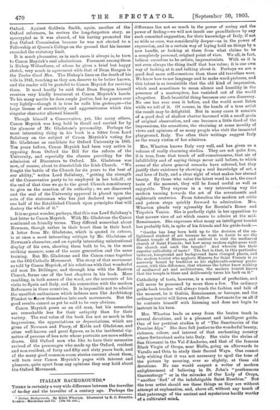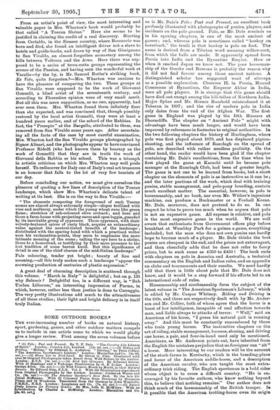ITALIAN BACKGROUNDS.*
THERE is certainly a very wide difference between the traveller of to-day and the traveller of a century ago.. Perhaps the
• Italian Backgrounds. By Edith Wharton. Illustrated by E. C. Peirotto. London : Macmillan and Co. [10a. 6d. net.1
difference lies not so much in the power of seeing and the power of feeling—we will not insult our grandfathers by any such conceited suggestion, for their knowledge of Italy, if not so wide as ours, was considerably deeper—as in the power of expression, and in a certain way of laying hold on things by a new handle, or looking at them from what claims to be
a completely personal, original point of view. We all, in fact, believe ourselves to be artists, impressionists. With us it is not even always the thing itself that has value; it is our own
way of looking at it and talking about it. Perhaps we are a good deal more self-conscious than those old travellers were. We know bow to use language and to make word-pictures, and this talent is so irresistible that the old kind of impression, which used sometimes to mean silence and humility in the presence of a masterpiece, has vanished out of the world altogether. Each beautiful thing becomes our own discovery. No one has ever seen it before, and the world must listen while we tell of it. Of course, in the hands of a true artist the result may be delightful. But in many cases it consists of a good deal of shallow chatter leavened with a small grain of original observation, and one becomes a little tired of the impressions, the sensations, the straining at some novelty of views and opinions of so many people who visit the immortal playground, Italy. Too often their writings suggest Italy as the weary victim of her admirers.
Mrs. Wharton knows Italy very well, and has given us a volume of really charming studies. They are not quite free, it is true, from that touch of self-consciousness, that air of infallibility and of saying things never said before, to which some of the above general remarks have referred, but they justify their existence by showing a real knowledge of art, a real love of Italy, and a clear sight of what makes her eternal beauty. By those who value the latest word in art, the exact taste of the moment, they will be found useful as well as enjoyable. They express in a very interesting way the modern turning towards the art of the seventeenth and eighteenth centuries. From toleration the modern art critic and patron steps quickly forward to admiration. Mrs.
Wharton pleads very agreeably for Bernini's Rome and Tiepolo's Venice. She is perfectly right in her opposition to that narrow view of art which ceases to admire at the mid- Renaissance. She expresses what many an intelligent tourist has probably felt, in spite of his friends and his guide-book:-
" Goethe has long been held up to the derision of the en- lightened student of art because he went to Assisi to see the Roman temple of Minerva, and omitted to visit the mediaeval church of Saint Francis; but how many modern sight-seers visit the church and omit the temple? And wherein lies their superior catholicity of taste The fact is that, in this particular insta-4ce, foreground and background have changed places, and the modern tourist who neglects Minerva for Saint Francis is as narrowly bound by tradition as his eighteenth-century prede- cessor, with this difference, that whereas the latter knew nothing of mediaeval art and architecture, the modern tourist knows that the temple is there and deliberately turns his back on it."
Catholicity of taste, however, is a counsel of perfection, and will never be possessed by more than a few. The ordinary guide-book teacher will always teach the fashion and talk of the moment, be it Gothic, Renaissance, or baroque, and the ordinary tourist will listen and follow. Fortunate for us all if he contents himself with listening and does not begin to
instruct in his turn.
Mrs. Wharton leads us away from the beaten track in several directions, and is a pleasant and intelligent guide.
One of her prettiest studies is of " The Sanctuaries of the Pennine Alps." She does full justice to the wonderful beauty, richness, colour, and interest of that enchanting country where Switzerland melts into Italy. She visits the shrine of San Giovanni in the Val d'Andorno, and that of the famous Black Virgin of Oropa, near Biella, going on afterwards to
Varallo and Orta to study their Sacred Ways. One cannot help wishing that it was not necessary to spoil the tone of the picture by sneering, ever so slightly, at these old devotions. No one would suspect a writer of modern enlightenment of believing in St. John's "posthumous thaumaturgy " or in the miracles of Our Lady of Oropa, "another ' find ' of the indefatigable Saint Eusebius." But the true artist should see these things as they are without attempt at explanation; and, above all, without any touch of that patronage of the ancient and mysterious hardly worthy of a cultivated mind.
From an artist's point of view, the most interesting and valuable paper in Mrs. Wharton's book would probably be that called "A Tuscan Shrine." Here she seems to be justified in claiming the credit of a real discovery. Starting from Certaldo, in the Sienese country, where Boccaccio was born and died, she found an intelligent driver not a slave to hotels and guide-books, and drove by way of San Gimignano to San Vivaldo, an almost forgotten monastery among the
hills between Volterra and the Arno. Here there was sup- posed to be a series of terra-cotta groups representing the scenes of the Passion, and having seen the wonderful work at Tarallo—by the by, is Mr. Samuel Butler's striking book, Es Vote, quite forgotten P—Mrs. Wharton was anxious to have the pleasure of comparing the two. These groups at
San Vivaldo were supposed to be the work of Giovanni Gonnelli, a blind artist of the seventeenth century, and according to Florentine opinion were of very small merit.
But all this was mere supposition, as no one, apparently, had ever seen them. Mrs. Wharton found them infinitely finer than she expected, and was convinced that, though possibly restored by the local artist Gonnelli, they were at least a hundred years earlier, and of the school of the Robbias. In fact, the "Presepio" at the Bargello, attributed to them, was removed from San Vivaldo some years ago. After ascertain- ing all the facts of the case by most careful examination, Mrs. Wharton had the San Vivaldo groups photographed by Signor Alinari, and the photographs appear to have convinced Professor Ridolfi (who had known them by hearsay as the work of Gonnelli) that they are in truth the work of Giovanni della Robbia or his school. This was a triumph in artistic criticism on which Mrs. Wharton may well pride herself. To rediscover for Italy one of Italy's real art treasures is an honour that falls to the lot of very few tourists of our day.
Before concluding our notice, we must give ourselves the pleasure of quoting a few lines of description of the Tuscan landscape, which show Mrs. Wharton's delicate talent of writing at its best. She is on the way to San Vivaldo :— " The elements composing the foreground of such Tuscan scenes are almost always extremely simple—slopes trellised with vine and mulberry, under which the young wheat runs like green flame ; stretches of ash-coloured olive orchard ; and here and there a farm-house with projecting eaves and open loggia, guarded by its inevitable group of cypresses. These cypresses, with their velvety-textured spires of rusty black, acquire an extraordinary value against the neutral-tinted breadth of the landscape ; distributed with the sparing hand with which a practised writer uses his exclamation-points, they seem to emphasise the more intimate meaning of the scene ; calling the eye here to a shrine, there to a homestead, or testifying by their mere presence to the lost tradition of some barren knoll. But this significance of detail is one of the chief charms of the mid-Italian landscape."
Pale colouring, tender yet bright ; beauty of line and meaning,—all this truly makes such a landscape "appear the crowning production of centuries of plastic expression."
A great deal of charming description is scattered through this volume. "March in Italy" is delightful ; but on p. 135 why Salamis ? Delightful too, in a different way, is " Sub
Umbra Liliorum," an interesting impression of Parma, in which, however, rather less than justice is done to Correggio. The very pretty illustrations add much to the attractiveness of all these studies; their light and bright delicacy is in itself truly Italian.











































 Previous page
Previous page